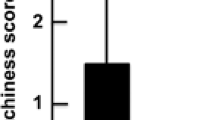Abstract
Recent histological and immunocytochemical analyses of venous leg ulcers suggest that lesions observed in the different stages of chronic venous insufficiency (CVI) may be related to an inflammatory process. This inflammatory process leads to fibrosclerotic remodeling of the skin and then to ulceration. The vascular network of the most superficial layers of the skin appears to be the target of the inflammatory reaction. Hemodynamic forces such as venous hypertension, circulatory stasis, and modified conditions of shear stress appear to play an important role in an inflammatory reaction accompanied by leukocyte activation which clinically leads to CVI: venous dermatitis and venous ulceration. The leukocyte activation is accompanied by the expression of integrins and by synthesis and release of many inflammatory molecules, including proteolytic enzymes, leukotrienes, prostaglandin, bradykinin, free oxygen radicals, cytokines, and possibly other classes of inflammatory mediators. The inflammatory reaction perpetuates itself, leading to liposclerotic skin and subcutaneous tissue remodeling. In light of the mechanisms of venous ulcer formation cited above, therapy in the future might be directed against leukocyte activation in order to diminish the magnitude of the inflammatory response. With this in mind, the attention of many investigators has been drawn to two different drugs with an anti-inflammatory effect: pentoxifylline and flavonoids.





Similar content being viewed by others
References
Homans J. The etiology and treatment of varicose ulcer of the leg. Surg Gynecol Obstet 1917;24:300–311
Brewer AC. Arteriovenous shunts. BMJ 1950;ii:270
Coleridge Smith PD. The drug treatment of chronic venous insufficiency and venous ulcerations. In Gloviczky P, Yao ST, eds. Handbook of Venous Disorders. Guidlines of the American Venous Forum, London: Arnold, 2001, pp 309–321
Cheatle TR, McMullin GM, Farrah J, Coleridge Smith PD, Scurr HJ. Three tests of microcirculatory function in the evaluation of treatment for chronic venous insufficiency. Phlebology 1990;5:165–172
Leu AJ, Leu H-J, Franzeck UK, Bollinger A. Microvascular changes in chronic venous insufficiency - a review. Cardiovasc Surg 1995;3:237–245
Moyses C, Cederholm-Williams SA, Michel C. Hemoconcentration and the accumulation of white cells in the feet during venous stasis. Int J Microsc Circ Clin Exp 1987;5:311–320
Thomas PRS, Nash GB, Dormandy JA. White cell accumulation in the dependent legs of patients with venous hypertension: a possible mechanism for trophic changes in the skin. BMJ 1988;296:1693–1695
Coleridge Smith PD, Thomas P, Scurr JH, Dormandy J. Causes of venous ulceration: a new hypothesis. BMJ 1988;296:1726–1727
Shields DA, Andaz SK, Abeysinghe RD, Porter JB, Scurr JH, Coleridge Smith PD. Neutrophil activation in experimental ambulatory venous hypertension. Phlebology 1994;9:119–124
Shields DA, Andaz SK, Sarin S, Scurr JH, Coleridge Smith PD. Plasma elastase in venous disease. Br J Surg 1994;81:1496–1499
Marschel P, Schmid-Schönbein GW. Control of fluid shear response in circulating leukocytes by integrins. Ann Biomed Eng 2002;30:333–343
Moazzam F, Delano FA, Zweifach BW, Schmid-Schönbein GW. The leukocyte response to fluid stress. Proc Natl Acad Sci USA 1997;94:5338–5343
Peshen M, Lahaye T, Hennig B, Weyl A, Simon JC, Vanscheidt W. Expression of the adhesion molecules ICAM-1, VCAM-1, LFA-1and VLA-4 in the skin is modulated in progressing stages of chronic venous insuffciency. Acta Derm Venereol (Stockh) 1999;79:27–32
Murphy MA, Joyce WP, Condron C, Bouchier-Hayes D. A reduction in serum cytokine levels parallels healing of venous ulcers in patients undergoing compression therapy. Eur J Vasc Endovasc Surg 2002;23:349–352
Coleridge Smith PD. Leg ulcers: biochemical factors. Phlebology 2000;15:156–161
Kim I, Moon SO, Kim SH, Kim HJ, Koh YS, Koh GY. Vascular endothelial growth factor expression of intercellular adhesion molecule 1 (ICAM-1), vascular cell adhesion molecule 1 (VCAM-1), and E-selectin through nuclear factor-κB activation in endothelial cells. J Biol Chem 2001;276:7614–7620
Abumiya T, Sasaguri T, Taba Y, Miwa Y, Miyagi M. Shear stress induces expression of vascular endothelial growth factor receptor Flk-1/KDR through the CT-rich Sp1 binding site. Arterioscler Thromb Vasc Biol 2002;22:907–913
Drinkwater SL, Smith A, Sawyer BM, Burnand KG. Effect of venous ulcer exudates on angiogenesis in vitro. Br J Surg 2002;89:709–713
Pappas PJ, You R, Rameshawar P, et al. Dermal tissue fibrosis in patients with chronic venous insufficiency is associated with increased transforming growth factor-beta 1 gene expression and protein production. J Vasc Surg 1999;3:1129–1145
Guillet G, Garcia C, Sassolas B, Lonceint J, Youninou P. Antiendothelial cell antibodies in chronic leg ulcers: prevalence and significance. Ann Dermatol Venereol 2001;128:1301–1304
Jantet G. Chronic venous insufficiency: worldwide results of the RELIEF study. Reflux assessment and quality of life improvement with micronized flavonoids. Angiology 2002; 53:245–246
Herouy Y, May AE, Pronschlegel G, et al. Lipodermatosclerosis is characterized by elevated expression and activation of matrix metalloproteinase: implications for venous ulcer formation. J Invest Dermatol 1998;111:822–827
Tarlton JF, Bailey AJ, Crawford E, Jones D, Moore K, Harding KD. Prognostic value of markers of collagen remodeling in venous ulcers. Wound Repair Regen 1999;7:347–355
Rogers AA, Burnett S, Lindholm C, et al. Expression of tissue-type and urokinase-type plasminogen activator activities in chronic venous leg ulcers. Vasa 1999;28:101–105
Jull A, Waters J, Arroll B. Pentoxifylline for treatment of venous leg ulcers: a systematic review. Lancet 2002;359:1550–1554
Barroso-Aranda J, Schmid-Schönbein GW. Pentoxifylline pretreatment decreases the pool of circulating activated neutrophils, in-vivo adhesion to endothelium, and improves survival from hemorrhagic shock. Biorheology 1990;27:401–418
Author information
Authors and Affiliations
Corresponding author
About this article
Cite this article
Pascarella, L., Schönbein, G.W.S. & Bergan, J.J. Microcirculation and Venous Ulcers:A Review. Ann Vasc Surg 19, 921–927 (2005). https://doi.org/10.1007/s10016-005-7661-3
Published:
Issue Date:
DOI: https://doi.org/10.1007/s10016-005-7661-3




